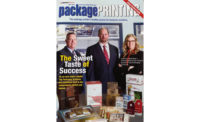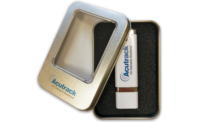New Age of Package Printing


Diet Coke’s digitally printed “Stay Extraordinary” campaign earned the brand a significant sales increase.

Digital presses create crisp graphics, and on a number of substrates. Pictured is the HP Indigo 20000.

In addition to consumer connection, by using digital technology, Coke saved materials from entering the waste stream.




Increasingly, many brands are choosing to print their packages on digital presses. Digital printing is nothing new; the technology we have today has been around, in large part, since the early 1990s.
What have changed are brands — now, more than ever, consumers expect brands to be personable and timely, and companies are looking for ways to respond to those developments.
On the flip side, something that will never waver is a brand’s need to save on the resources of money, time and materials. Any technology that can lower expenditures in those areas is worth examining.
BRANDPACKAGING talks with Gary Bernier, strategic business & brand development, HP Indigo Labels & Packaging, Americas, about digital printing and what the technology can help brands achieve and accomplish.
BRANDPACKAGING (BP): What is digital printing?
GARY BERNIER (GB): Digital printing enables a user to eliminate costly and time-consuming analog steps associated with conventional printing.
It allows the user to stay in the digital world up to the time when ink is applied to the substrate — no plates or cylinders to make or mount, and no time or materials getting the plates into register.
Digital printing can print the same graphics over and over just like conventional printing, but it also allows the user to stream a wide variety of graphical content so every label, shrink sleeve, folding carton or flexible package can be unique effortlessly.
BP: What are the benefits of digital printing?
GB: There are several perspectives to consider. The benefits from a printer/converter perspective are different than from a brand/retailer perspective.
Printer/Converter perspective:
Digital printing allows them to profitably expand their product portfolio to address a wider range of solutions for their customer base. Digital printing gives printers and converters the ability to:
- Produce shorter run lengths with higher margins versus doing it conventionally. There is faster make-ready, less waste, no plates or cylinders, and ultra-quick changeover between SKUs.
- Address the desire of their customer base to deliver product faster and with higher quality.
- Eliminate or dramatically reduce capital tied up in managed inventory services and move to just-in-time manufacturing solutions.
- Produce customized products that contain variable content.
- Match conventional print. Since HP Indigo digital printing technology actually prints a “dot,” the ability to match conventional print is a huge benefit, allowing printers and converters to print higher volume SKUs conventionally and lower volume SKUs on the HP Indigo.
Brand/Retailer perspective:
Digital printing allows them to provide solutions to target and connect with consumers on a personal level, resulting in increased market share and increased sales. Benefits include:
- Customized product decoration based on specific demographics.
- Lowered risk associated with new launches. Brands can print the minimum volume to launch a product and then replenish based on the demand at SKU level.
- Increased speed-to-market.
- Improved cash flow for work-in-progress inventory.
BP: What sorts of materials can be printed digitally?
GB: A competitive edge starts with substrate flexibility. The versatility of HP Indigo digital presses allows users to produce a wide range of package decoration such as labels, shrink sleeves, folding cartons and flexible packaging. With the ability to print on substrates as thin as 10 micron films and as thick as 24 point folding carton stock, HP Indigo digital presses provide the flexibility businesses need today.
Substrates include standard supported and unsupported films, and paper-based and even metalized substrates are printed around the world every day. We also have customers who print on specialized substrates such as wood veneer and rice or tissue paper to provide high impact on the store shelves.
HP digital print technology also addresses a wide gamut of corrugated materials for point of purchase as well.
BP: How can printing digitally help brands financially?
GB: There are many examples of how brands have leveraged HP digital printing technology and enjoyed financial benefits from doing so. The recent highly successful “Share a Coke” campaign is an example of how connecting with consumers on a personal level increases market share.
There are also many examples of brands that have benefitted from digital printing by producing product decoration “just in time,” based on demand at the SKU level rather than purchasing inventory of product decoration.
Digital printing is more than just another way to put ink on a substrate; it provides value at every step of a product’s life cycle:
- Designers are no longer strapped with having to design within the limitations of conventional print, having to print exactly the same thing over and over. They now have perfect ink-to-ink registration and the ability to introduce variable content to better attract and connect with the consumer.
- Brands no longer have to print high volumes of inventory at the launch of a product. They can print just the minimum volume needed to get product into their distribution system, improving cash flow.
- During the replenishment phase of a product’s life cycle, they can print volume based on consumer demand at the SKU level, reducing obsolete inventory issues. Another big financial value here is 100 percent revision control. Because it’s a digital workflow, every time a brand prints, it has the ability to address revisions quickly and easily at far less cost than conventional printing.
- Once the brand has decided it’s time to phase out the current product decoration and introduce a refreshed look, the “phase out” period is dramatically reduced, allowing the new design to hit store shelves faster, because there is less inventory of the old design to burn through.
BP: How can digital printing help brands with regions where sales are lagging?
GB: Think of a consumer in Miami. What do they do for fun? What kind of music do they listen to? What do they do in their spare time? What kind of food do they eat? What is important to them?
Now think about a consumer in Seattle. Do you see the same consumer?
Historically, brands have designed their product decoration to try and connect with consumers regardless of where they reside. This is because the cost of trying to print local, city, state or regional product decoration would be far too costly with conventional printing. With digital printing, it becomes a viable option.
Another note here is the impact digital printing makes on the ability to use this technology to test market products before large-scale launches. This helps brands in regard to testing the market with appropriate products and messages to make sure they are hitting the mark before launch.
BP: Gary, you spoke to us at PACK EXPO about the introduction of chaos (placing design elements in different places on packaging) to draw consumers’ eyes; they see an active display rather than a staid wall of like products that can easily be glazed over. How does digital printing allow that?
GB: With HP Indigo digital printing technology, every revolution of the print cylinder can print different elements. This is called variable content or variable data printing. Variable content has been used in other print markets for years, such as direct mail where each printed piece is customized specifically to the targeted consumer. With HP, this capability is now being used in package decoration.
One great example of this technology is a recent promotion for the Israeli market. Utilizing variable content printing and a patent-pending hyper-customization technology from HP called Mosaic, The Coca-Cola Company produced millions of unique pieces of art, streamed the millions of versions to our HP Indigo WS6600 Digital Presses and put millions of totally unique shrink sleeves on the store shelves! In this example, the brand enjoyed a significant sales increase.
BP: For brands concerned with sustainability, can digital printing assist them in their environmental goals?
GB: HP Indigo digital printing can make a dramatic impact on the sustainability goals of any brand or retailer.
For example, consider an average five-color label. For a conventional flexo printing press, to get these five inks in registration and then up to targeted “color,” a good printer may use about 900 to 1000 feet of substrate. An HP Indigo digital press would use about 30 feet. That is a waste stream reduction of about 97 percent for the first SKU!
Depending on the number of ink/plate changes for additional SKUs, the sustainability impact of HP Indigo digital printing can be dramatic.
When a brand can print only the volume it needs, when it’s needed, it can virtually eliminate obsolete inventory that today goes into landfills. HP Indigo digital presses are also manufactured carbon neutral, which again, has an effect on the total sustainability picture.
BP: Do you have any examples of brands using digital printing’s capabilities to the fullest?
GB: Excellent examples of brands using HP Indigo digital printing technology include:
- Coca-Cola’s “Share a Coke” campaign
- Diet Coke’s Extraordinary Collection in Israel
- Pepperidge Farm’s Goldfishmyway.com
- Kleenex’s MyKleenextissue.com
BP: Is there anything else you’d like to add that speaks to digital printing’s benefits for brands?
GB: If you boil down the true value of digital printing, it gives you the ability to:
- Print what you want: Technically, with digital printing you can print 10, 10,000 or even 10,000,000 units.
- Print when you want it: HP Indigo digital printing technology can reproduce brand integrity colors with extreme consistency — today, tomorrow, next month or next year, brands can truly leverage just-in-time manufacturing and receive their package decoration based on when they are actually producing the product. Deliveries can be scheduled on a weekly, bi-weekly or monthly basis — or in any increment that best suits their schedule.
- Print how you want it: This means revision control. Since you are printing more frequently versus conventional print, every time you print is an opportunity to incorporate any change you wish. Seasonality of the package decoration? No problem. Holidays or promotional opportunities? No problem. Internal changes? No problem. City, state or federal regulation changes? No problem.
Brands and retailers around the world are leveraging these values every day. The possibilities are endless for brands that leverage the above values in their package decoration go-to-market strategy.
Less than 15 years ago the commercial print market was trying to understand the value, relevance and fit for digital. HP has been part of the remarkable transformation in the market, and there’s more to come. The packaging market is at an early stage of a similar transformation with increasing consumer demands, global market needs, shorter life cycle, sustainability concerns and the overwhelming desire for marketers to stand out in the noise and better connect with their target customers.
Looking for a reprint of this article?
From high-res PDFs to custom plaques, order your copy today!











